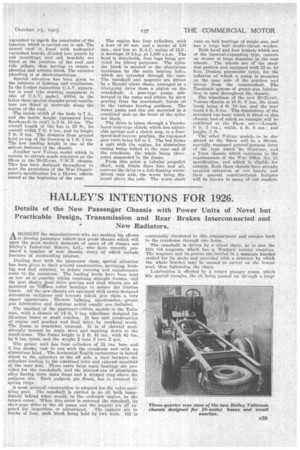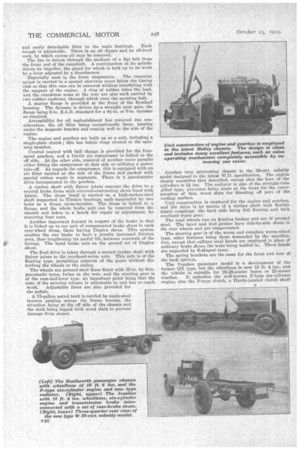HALLEY'S INTENTIONS FOR 1926.
Page 23

Page 24

Page 25

If you've noticed an error in this article please click here to report it so we can fix it.
Details of the New Passenger Chassis with Power Units of Novel but Practicable Design, Transmission and Rear Brakes Interconnected and
• New Radiators.
AAIONGST the manufacturers who are making big efforts to develop passenger vehicle and goods chassis which will meet the most modern demands of users of all classes are Halley's Industrial Motors Ltd., who have recently produced a number of new Chassis, many of which include features of outstanding interest.
Dealing first with the passenger class, special attention has been given to their general construction, springing, braking and fuel economy, to reduce running and maintenance costs to the minimum. The loading levels have been kept as low as is passible whilst retaining straight frames, and the gear shafts, final drive gearing and road wheels are all mounted on Tiritken roller bearings to reduce the friction losses. All the new chassis are equipped with newly-designed streamline radiators and bonnets which give them a very smart appearance. Electric lighting, speedometer, grease gun lubrication and ...kutovac petrol supply are included.
The smallest of the passenger-vehicle models is the Talisman, with a chassis of 14 ft. 3 ins, wheelbase designed for 20-seater buses or small coaches. It has unit construction of engine and gearbox and final drive by overhead worm. The frame is somewhat unusual. It is of channel steel, strongly trussed by angle steel and tapering down to the dumb-irons. The frame height is 2 ft. rif ins.. with 42 ins. by 6 ins. tyres, and the weight 2 tons 3 cwt. 2 qrs.
The power unit has four cylinders of n ins, bore and 5 ins, stroke, cast in one with the crankcase and with an aluminium hied. The horizontal Zenith carburetter is bolted direct to the cylinders at the off side, a duct between the cylinders leading to the combined inlet and exhaust manifold at the near side. Three extra large main bearings are provided for the crankshaft, and the pietona, are of aluminium alloy having three main rings and a scraper ring above the gudgeon pin. Each gudgeon pin floats, but is retained by spring rings.
A most unusual construction is adopted for-the valve-operating gear. The camshaft is carried in an oil bath immediately behind what would, in the ordinary engine, be the tappet cover. When this cover is removed the camshaft, its skew-gear drive to the oil pump and the tappets are all exposed for inspection or adjustment. The tappets are in blocks of four, each block being held by two nuts. Oil is continually circulated to this compartment and escapes back to the crankcase through two holes.
The camshaft is driven by a silent chain, as is also the Blic 04 magneto, which has a Watford vernier coupling. The magneto and its pinion are carried in a separate bracket slotted for its studs and provided with a setscrew by which the whole bracket may be caused to swivel on the lowest stud, thus tightening the chain.
Lubrication is effected by a rotary plunger pump, which fills special troughs, the oil being passed up through a large and easily detachable filter to the main bearings. Each trough is adjustable. There is an oil dipper and an oil-level c-ock, by which excess oil may be removed.
The fan is driven through the medium of a flat belt from the front end of the camshaft. A continuation of its spihdle drives an impeller, the gland for which is held up to its work by a lever adjusted by a thumbscrew.
Especially neat is the front suspension. The trunnion spigot is carried in a special cast-iron cover below the timing case so that this ease can be removed without interfering with the support of the engine. A ring of rubber takes the load, and the crankcase arms at the rear are also each carried by two rubber cushions, through which runs the securing bolt.
A starter flange is provided at the front of the flywheel housing. The dynamo is driven by.a straight spur gear, the flange being 5-in. S.A.E. standard for a 4i-in. or 5-in, dynamo as required.
Accessibility for oil replenishment has received due consideration, the oil filler being exceptionally large. passing under the magneto bracket and coming well to the side of the engine.
The engine and gearbox are built up as a unit, including a single-plate clutch ; this has fabric rings riveted to the spinning member.
Central control with ball change is provided for the fourspeed gearbox, and a David air compressor is bolted to the off side. At the other side, removal of another cover permits either fitting the compressor at that side or utilizing a power take-off. As regards the compressor, this is equipped with an air filter carried at the side of the frame and packed with special cotton waste in segments. There is a speedometer drive incorporated in the gearbox.
A cardan shaft with Spicer joints conveys the drive to a central brake drum with external-contracting shoes lined with fabric. The drum itself is carried on a high-carbon-steel shaft supported in Timken bearings, each suspended by two bolts to a frame cross-member. The drum is bolted to a flange, and the whole brake unit can be removed from the chassis and taken to a bench for repair or adjustment, by removing four nuts.
Another important feature in respect of the brake is that it is linked up to one pair of compensated brake shoes in each rear-wheel drum, these having Duplex shoes. This system enables the one brake to have a greatly increased friction area, thus lengthening its useful life ,between renewals of the linings. The hand brake acts on the second set of Duplex shoes.
The final drive is taken through a second eardan shaft with Spicer joints to the overhead-worm axle. This axle is of the floating type, permitting removal of the gears without disturbing the wheels or the casing.
The wheels are pressed-steel discs fitted with 32-in. by 6-in. pneumatic tyres, twins at the rear, and the steering gear is of the cam-and-lever type, an important point being that the rake of the steering column is adjustable to suit bus or coach work. Adjustable faces are also provided for The pedals.
A 15-gallon petrol tank is carried by angle-steel bearers passing across the frame trusses, the situation being at the off side of the chassis and the tank being lagged with wood slats to prevent damage from stones.
Another very interesting chassis is the 30-cwt. subsidy model designed to the latest W.D. specification. The engine closely resembles that described, except that the bore of the cylinders is n ins. The radiator is also of the straight-tube gilled type, provision being made at the front for the incorporation of thin wood slats for blanking off part of the cooling surface.
Unit construction is employed for the engine and gearbox, and the drive is by means of a cardan shaft with flexible fabric couplings the back axle being -full floating and with. overhead worm gear.
The road wheels run on floating bushes and are of pressed steel. The hand and foot .rakes have side-by-side shoes in the rear wheels a_nd are compensated.
The steering gear is of the worm and complete worm-wheel type, other features being those demanded by the specification, except that calliper steel bands are employed in place of ordinary brake shoos, the webs being welded in. These bands are expanded by S-shaped cams.
The spring brackets are the same for the front and rear of the back spring's.
The Ivanhoe passenger model is a development of the former QX type, but the wheelbase is now 15 ft. 4 ins., and tha vehicle is suitable for 25-26-seater buses or 23-seater
coaches. It embodies the well-known P-type six-cylinder engine, also the P-type clutch, a Hardy-jointed clutch shaft leading to the four-speed box three-point-suspended on crossmembers and previded with right-hand change.
The transmisfron brake is coupled up with a pair of rear brake shoes in the same manner as in the Talisman. Eightinch-pitch Hardy joints are used for the propeller shaft, a p:unger joint being provided at the front end. The final drive is by overhead worm. This chassis also has the braced flame, as in the Talisman, and the same positioning of the petrol tank.
Spherical bearings to prevent binding are provided in the change-speed mechanism, and the selector mechanism is separate from the gearbox.
The powerful engine permits high speeds, and for this reason special attention has been paid to springing.
The Kenilworth chassis has a P-type engine and A wheel base of 16 ft. 6 ins. It somewhat resembles the original
P-type chassis, but the gearbox is carried farther back, and there is a transmission brake behind the gearbox, this giving a greater wearing area than the older form of internalexpanding brake mounted at the tail of the wormshaft. It is chiefly intended for buses carrying approximately 32 paseen_ gers, and has a rolled channel-steel frame, strongly trussed. So far as the goods chassis are concerned, there is a new 2-tonner known as the Y type. This has the 3i-in. bore engine already described, a subsidy-type radiator and other units, as in the Talisman, except that there is a large diameter tubular propeller shaft with Spicer joints.
The petrol tank, in this case, is on the dash, and the brakes both operate in the rear-wheel drums only.
A standard P-type chassis and an S-type with units as in the former, but on a 12eft. 1-in, wheelbase, are also in pro duction. •






























